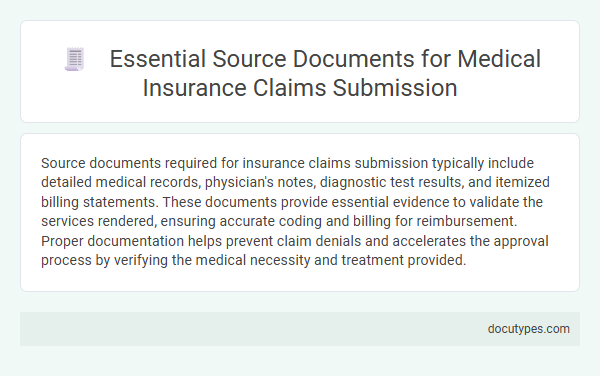Source documents required for insurance claims submission typically include detailed medical records, physician's notes, diagnostic test results, and itemized billing statements. These documents provide essential evidence to validate the services rendered, ensuring accurate coding and billing for reimbursement. Proper documentation helps prevent claim denials and accelerates the approval process by verifying the medical necessity and treatment provided.
Introduction to Medical Insurance Claims
Medical insurance claims require accurate documentation to ensure proper processing and reimbursement. Understanding the essential source documents helps healthcare providers submit claims efficiently and avoid denials.
- Patient Identification Documents - These include insurance cards and government-issued IDs to verify patient identity and coverage eligibility.
- Medical Records - Comprehensive clinical notes, diagnosis codes, and treatment details support the necessity of the services provided.
- Billing and Coding Records - Accurate billing statements and procedural codes (CPT, ICD-10) are essential for claim processing and reimbursement accuracy.
Definition and Importance of Source Documents
Source documents in medical insurance claims are original records that provide evidence of patient care and treatments delivered. These documents include medical charts, physician notes, lab reports, and billing statements essential for verifying claim accuracy.
Accurate source documents ensure proper reimbursement by validating the services billed to insurance providers. They play a critical role in preventing claim denials, audits, and fraud in healthcare billing processes.
Patient Demographic Information
Patient demographic information is essential for accurate insurance claims submission. This data ensures the insurance provider accurately identifies the insured individual and processes the claim efficiently.
- Patient Identification - Includes full name, date of birth, and unique patient ID for precise matching with insurance records.
- Contact Information - Consists of current address and phone number to facilitate communication during claim processing.
- Insurance Details - Contains policy number, group number, and provider name to verify coverage and benefits.
Medical Practitioner’s Notes and Clinical Documentation
Medical practitioner's notes and clinical documentation are essential source documents for insurance claims submission. These records provide detailed information about the diagnosis, treatment plan, and patient progress, ensuring accurate claim processing. You must maintain complete and clear documentation to support the medical necessity and authenticity of the services billed.
Medical Diagnosis and Procedure Codes
Which source documents are required for insurance claims submission related to medical diagnosis and procedure codes? Accurate medical diagnosis and procedure codes must be documented in the patient's medical records to support claims. You should ensure that all relevant clinical notes and coding details are included to facilitate smooth claim processing.
Treatment Authorization and Referral Forms
Treatment authorization forms are essential source documents required for insurance claims submission, confirming pre-approved medical services. These forms provide insurers with necessary details about the type and duration of authorized treatment.
Referral forms serve as critical documents verifying that a patient has been directed to a specialist or specific medical service by a primary care provider. Insurers use referral forms to ensure that the claim corresponds to an approved pathway of care, preventing unauthorized treatments.
Detailed Itemized Billing Statements
Detailed itemized billing statements are essential source documents for insurance claims submission. They provide a clear breakdown of all medical services, procedures, and charges incurred during treatment.
Your insurance provider relies on these statements to verify the accuracy of charges and to process claims efficiently. Detailed billing helps prevent claim denials and accelerates reimbursement. Ensuring all items are clearly listed supports compliance with payer requirements and facilitates transparent communication between healthcare providers and insurers.
Proof of Payment and Receipts
| Source Document | Description | Importance for Insurance Claims |
|---|---|---|
| Proof of Payment | Official document showing payment made to the healthcare provider. It includes payment date, amount, payer details, and method of payment. | Confirms that the patient or insured has fulfilled financial obligations for medical services. Validates claim authenticity and prevents fraudulent submissions. |
| Receipts | Itemized statements provided by healthcare facilities or pharmacies outlining services rendered and related costs. Often includes service codes and provider identification. | Serves as evidence of charges incurred during medical treatment. Essential for verifying claim amounts and ensuring accurate reimbursement from insurance companies. |
Medical Necessity Letters and Supporting Documents
Medical necessity letters are essential source documents for insurance claims submission, providing detailed justification for prescribed treatments or procedures. Supporting documents, such as diagnostic test results, physician notes, and prior authorization approvals, reinforce the medical necessity claim. These documents collectively ensure accurate claim processing and reduce the risk of denials by insurance providers.
Which Source Documents Are Required for Insurance Claims Submission? Infographic

